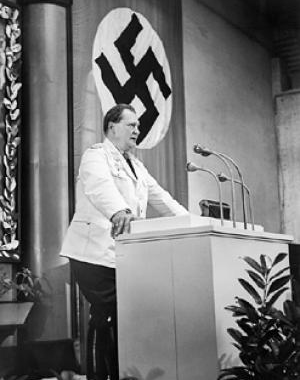Photo by Hoffmann Heinrich [Public domain], via Wikimedia Commons
Anyone who writes in the Historical Fiction genre must deal with the problem of how to portray real historical characters. Many authors feel free to make up their own interpretations without bothering to dig deeply into factual material. I have never felt that way. When I write about real people, I go to great lengths to illuminate the actual character of the subject based on exhaustive research. The most frequently portrayed real person in my novel, Fall Eagle One, is Hermann Göring, the World War II head of the German Luftwaffe.
The stereotype of Göring in popular consciousness is that of a fat, bumbling buffoon, reinforced by such motion pictures as The Battle of Britain. I could have adopted this caricature without fear of criticism and built my story around it. But I decided to check the facts first. I started by reading two biographies of the Reich Marshal and then branched off to scanning books about other Luftwaffe luminaries. What I discovered was a much more complex character than the popular stereotype.
Göring spoke of himself as a Renaissance man, and he was not far off the mark. He would have been quite at home in the court of a 1500s Italian prince. He was cunning and possessed a near genius IQ. Considering his World War I record, his courage can hardly be questioned. A skilled deer stalker, he wrote the German game statutes that remain in effect to this day. He also opposed vivisection and wrote his beliefs into law. But he did not have the same concerns for other human beings he considered “inferior races.” He presided over bloody purges in the Nazi party and hated Jews as avidly as did Hitler. The man appeared to be totally amoral. Like Hitler, he considered conscience a “Jewish concept” that had no validity. Perhaps his greatest sin was that he made the Nazi Party respectable at a time when many Germans considered them nothing but thugs.
Göring was also avaricious and somewhat lazy. He looted art treasures from all over Europe (he was in Paris buying paintings when the disastrous decision to supply Stalingrad by air was made by his subordinates). He tended to sign documents without reading their contents. One biographer relates how he authorized the Holocaust without troubling himself to read what the order contained.
Göring became addicted to morphine while recovering from a gunshot wound to the groin, which he received during the Munich Putsch. He never completely recovered. While he wore makeup and occasionally practiced cross-dressing, he appears to have been heterosexual. He engaged in numerous affairs and lived openly with both his wives while they were still married to other men.
Like Hitler, Göring may be considered evil incarnate. I believed my readers deserved an accurate portrait of his Machiavellian totality.
Note: My current novel, Fall Eagle One, a novel of World War II, is currently available for Kindle or in paperback from Amazon.com.


No comments:
Post a Comment